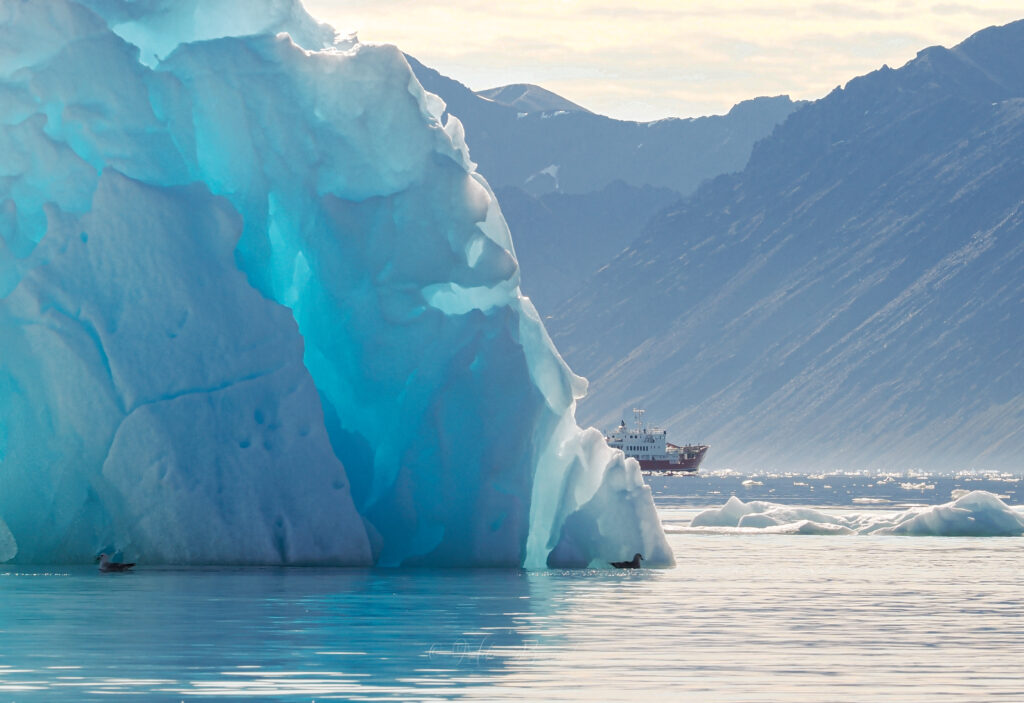After years of leading trips through these waters, I was finally seeing the Arctic from a different perspective. No logistics to manage, no schedules to keep, no responsibilities. Just the raw, untamed beauty of the north and two weeks of exploration ahead.

Svalbard in summer is a world of perpetual daylight. The sun circles above, never setting, casting an ethereal glow over the mountains, glaciers, and icy waters. Birds were fledging, ice was melting, and nature was in motion. Even after a decade of traveling these waters, this trip promised something new.
We settled into our cabins, went through the usual safety briefing, and then we were off. With no strict itinerary, we had the luxury of adapting to the moment. That’s when the first whisper of excitement came—there had been a Polar bear sighting near the bird cliffs of Alkhornet. A detour was in order.
The Guillemot Leap and a Change in Weather
Alkhornet is one of Svalbard’s great wildlife spectacles, home to thousands of nesting seabirds. This time of year, the guillemot chicks were fledging, taking their first, often chaotic, leap from the cliffs. They had never flown before—some would make it, others wouldn’t. The ones that struggled would attract the opportunists: Glaucous gulls, Arctic foxes, and sometimes even polar bears, waiting for an easy meal.

As we approached, anticipation was high. Would we see the dramatic spectacle of guillemot chicks tumbling through the air? Would the local predators be on the hunt?
But nature had other plans. The sky darkened, the wind picked up, and within minutes, the Arctic reminded us who was in charge. The weather had turned, making a landing impossible. Disappointed but undeterred, we pressed northward, knowing the Arctic always has more to offer.


Ny-Ålesund: Past, Present, and a Polar Bear
The next morning brought clear skies and a new opportunity. We received permission to land at Ny-Ålesund, a remote settlement with a rich history. Once a coal mining town, and launchpad for airships it has transformed into a hub of Arctic research. The streets were quiet, the air crisp, and the sense of history palpable.

We wandered through the small museum, learning about the miners who once toiled here and the explorers who passed through—including Roald Amundsen, who launched his airship Norge from this very spot. The airship mast still stands, a relic of a time when the race to the North Pole was at its most daring.
By afternoon, we were sailing into Krossfjorden, the sea calm as glass. It was the perfect setting to practice boarding the zodiacs—the small, inflatable boats that would become second nature to us over the coming days. We cruised along a glacier front, dwarfed by the towering blue ice and surrounded by swooping Arctic birds.



Then, just as dinner was being served, the call went up:
“Bear!”
Excitement rippled through the ship as everyone scrambled for binoculars and cameras. There, on the shoreline, a polar bear lay curled up, fast asleep. We watched in hushed awe. After a while, it stirred, stood up, stretched, and wandered down to the water’s edge. For a moment, it waded into the shallows before ambling off, disappearing into the Arctic wilderness.
It wasn’t the closest or most dramatic encounter, but it was many guests first. And in Svalbard, the first polar bear sighting always feels like a moment of magic.

A Promising Start
With just one day behind us, we had already detoured for a bear sighting, weathered an Arctic storm, walked in the footsteps of polar explorers, and witnessed our first polar bear. The journey was only beginning, and already, Svalbard was proving why it never gets old. There were no guarantees of what we would find in the days ahead, but one thing is certain—the Arctic always surprises you.

As the Vikingfjord sailed further north into the midnight sun, I found myself thinking: what wonders would tomorrow bring?

